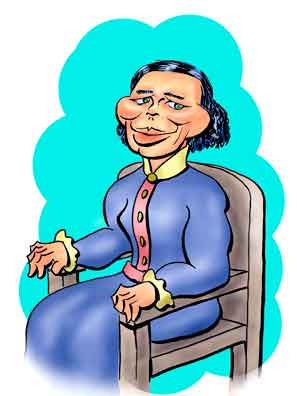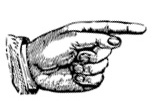Clara Barton

Everyone knows about Clara Barton. During the American Civil War Clara Barton was
 | A clerk in the United States Patent Office. |
Ha? (To quote Shakespeare.) Did you say that during the American Civil War Clara Barton was:
 | A clerk in the United States Patent Office. |
Of course when she began to take care of the sick and wounded soldiers, she was given a leave from her Patent Office duties. But after the war she (briefly) returned to her job in the stacks.
Born in New Oxford, Massachusetts, Clara was the youngest of the four children of Stephen and Sarah Stone Barton. You'll read that Clara had no formal nursing training. That's true enough, but then no one at that time had formal nursing training. There were no nursing schools although Clara's contemporary, Elizabeth Blackwell, managed to be the first woman to graduate from medical school.
So like all nurses of the time, Clara got her experience on-the-job. In her case it was taking care of her older brother, David. In 1833, David, then in his mid-twenties, had been working on a barn raising - which is the raising of a barn - when he slipped from the roof. Although he landed on his feet and appeared unharmed, he later developed a fever and rapidly got worse. He was bed-ridden for two years.
Clara cared for her brother almost continuously. Finally the doctors declared his case hopeless, and they discontinued their treatments. Of course their most common - quote - "treatment" - unquote - was bloodletting so it's no surprise that once the doctors left him alone, David almost immediately recovered. He later served as a captain in the Union Army and died in 1888 at age 79.
It was soon evident that Clara was not really interested in becoming a housewife. She liked learning and the only time she had not done well as a student was when her folks shipped her off to a boarding school. She quickly returned to New Oxford.
So Clara decided to become a teacher. She was, if not unorthodox, then what we'd call innovative. She specialized in setting up schools where schools were hard to set up. Clara's usual mode of operation was to establish a school, stay at it for a couple of years, and then turn it over to others after it was up and running.
There's some controversy of how old Clara was when she began teaching. She later said she was seventeen (or eighteen), but she also mentioned that on her first job, some of the kids were nearly her own age. At that time kids often entered colleges at age fourteen, so some historians think Clara really was only about fifteen.
Whatever her age when she became a professional woman, Clara had an interesting philosophy toward getting paid. She said although she might agree to teach for nothing, if she was going to get paid anything, it was going to be for the same salary as a man. If the administrators didn't agree, they could get someone else.
After about ten years of teaching and setting up schools around New Oxford, Clara herself went back to school. She attended what was the Clinton Liberal Institute in Kirkland, New York. This school was unusual in that it was coeducational although men and women attended separate classes. As with most colleges of the time it was associated with a church which in this case was the Universalists.
Universalists had what was then an unusual (and now increasingly rare) doctrine in that they believed in separation of church and state, did not accept the literal interpretation of the Bible, and didn't believe that a kind and loving God would set up a system where the majority of people who had beliefs contrary to their own would end up suffering eternal torment. But what really shook people up was that the Universalists, like the Congregationalists, had no problem with the ordination of women.
And they were abolitionists.
Today it's difficult to appreciate how rapidly and complete was rise of the abolitionists. In 1830, they barely made the news. But by 1835 abolitionists had become the big bogeymen for the citizens of the South and were denounced as dangerous radicals that were destroying the fabric of the country. The abolitionists, led by William Lloyd Garrison, were quite happy with such a characterization. Clara became a staunch abolitionist.
Clara didn't graduate from the Clinton Institute. Although the tuition, room, and board was only about $35 a term, that was still a hefty good chunk of dough at the time and about what you'd pay to rent a house for a year. But whatever the reason, Clara dropped out and returned to teaching.
The year 1854 was particularly strenuous and Clara had a physical collapse. It was then that she was hired as a clerk by the patent office. As you might expect, the male employees resented her presence and generally created a hostile environment which involved making rude noises and comments and directing their tobacco juice her way.
Then in 1857 James Buchanan became the president. With the new administration both Clara and her boss and mentor, Charles Mason, found themselves out of their jobs. So she returned to New Oxford. But after James's mercifully brief term, Abraham Lincoln was elected and Clara got her job back. Abe it seems had no problem with career women in the government.
Washington, though, was not a happy city. By the time Lincoln was inaugurated, seven states had seceded from the Union, and Washington was surrounded by slave states (yes, Maryland was a slave state). People were expecting war to break out between the North and the South. The South would then invade the District of Columbia and force the North to accept the Confederate States as an independent country.
Things were certainly looking that way. A Union regiment was traveling through Baltimore and had been attacked by a mob. Three soldiers were killed and a number wounded. When the train with the soldiers arrived in Washington, Clara took some of the injured soldiers to the home of her sister Sally and others were put up in the Senate chambers.
Although Clara did some actual tending to the soldiers and assisted the surgeons, more and more she worked at obtaining and getting needed supplies, particularly clothes and medical supplies, to the soldiers. She quickly became known to the major officers and politicians who were impressed with her energy, ability, and the fact that she drummed up the money and supplies herself. Usually she would put ads in papers asking for donations and the response was impressive.
Unfortunately once supplies were in her hands, she had to get them to the soldiers. That wasn't much of a problem at the Battle of Bull Run where the wounded were removed quickly to Washington. But soon it became evident the help was really needed where the battles were actually fought. Clara must have had considerable powers of persuasion. Getting authority to travel to the front wasn't easy, but Clara managed to do it.
Clara first served in the field at the Battle of Cedar Mountain in 1862. But the first battle she was at before the fighting started was at Antietam in 1863. It was there we read that a bullet passed through her sleeve, leaving her unharmed but killing the solider she was tending. She later was at the Battle of Fredericksburg, the Bombardment of Charleston, the Siege of Fort Wagner, the Battle of the Wilderness, and the Battle of Spotsylvania Courthouse.
After the war and with Lincoln's approval, Clara began investigating the whereabouts of the soldiers who were missing in action. This activity took her to Andersonville, Georgia, where she began working with a former prisoner, Dorence Atwater, who had kept a secret list of those who died. She and Dorence went through the records and surveyed the cemetery, ultimately identifying most of the 13,000 gravesites.
After the war Clara needed a respite. She began lecturing (again insisting she get compensated at parity with men) and appeared with luminaries like Mark Twain and Susan B. Anthony. Most of her talks were about her own experiences but she also advocated votes for women and civil rights for all.
As anyone knows, lecturing isn't always that relaxing, and Clara finally decided she needed a real break. So in 1869 she traveled to Europe, and while in Geneva she met Louis Appia, the head of the International Red Cross. The Red Cross had been organized in 1863 in conjunction with the newly negotiated Geneva Convention. Clara was surprised that there was no American branch of the organization. It wasn't until 1882 that the United States government ratified the first Geneva Convention which gave official sanction to the Red Cross for disaster relief.
Europe, though, was not a peaceful place to be. Germany had begun trying to unify the separate states into one happy empire, and in doing so they annexed certain areas claimed by France. The French leader, Napoleon III, was the nephew of the Napoleon and there wasn't any nephew of Napoleon who was going to set back and do nothing when France's land was being snitched.
So in 1871, the Franco-Prussian War broke out which France promptly lost. As you'd expect, Clara got involved with the relief efforts. She even entered Paris when the Commune was in charge - something not for the fainthearted.
From 1884 to 1904 Clara headed the American Red Cross. Among the efforts she directed were relief efforts of floods, epidemics, fires, droughts, and wars. She often appeared on the scene herself even though she wasn't getting any younger.
Clara finally retired to Washington, D. C.. She lived another eight years, dying in 1912 at age 90 in the Washington suburb of Echo Park.
References
The Story of My Childhood, Clara Barton, Baker and Taylor, 1907.
Clara Barton, Leni Hamilton, American Women of Achievement, Chelsea House Publishers, 1988.
The Life and Times of Clara Barton, Susan Harkins and William Harkins, Mitchell Lane Publishers, 2008.
"Clara Barton (1821-1912)", Debra Michals, PhD, National Women's History Museum, 2015.
"Clara Barton", Clara Barton National Historical Site.
"Clara Barton and Andersonville", Andersonville National Park
"Clarissa Harlowe 'Clara' Barton'", Find-a-Grave.
"David Barton", Find-a-Grave.